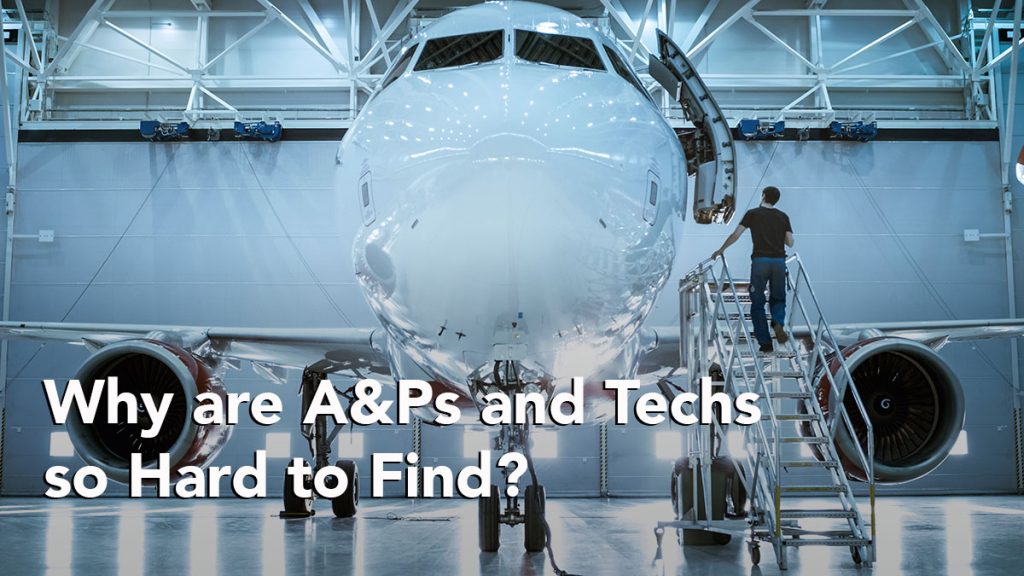
The pandemic’s impact on the aviation industry needs no explanation.
Within days of countries reacting to the fast-moving virus, national and international flights were slammed to a halt. As revenue shrunk, companies began to face the reality of needing to save costs — and reduce their workforce. With aircraft sitting and maintenance deferred, many of those reductions were Airframe and Powerplant (A&P) mechanics and aviation technicians.
As the pandemic’s threat recedes and flights resume, the industry is facing the stark reality of fewer trained and certified mechanics returning to meet demand.
What happened to the A&P workforce — and how can companies find new technicians to fill much-needed roles?
How Did COVID-19 Disrupt the Aviation Mechanic Industry?
Part of the reason behind the lack of available technicians may be due to a pandemic-induced decrease in newly trained A&Ps and aviation technicians. Reports from the Aviation Technician Education Council show that in 2020 there were 30% fewer A&P certificates issued by the FAA than the year before.
A reduction in numbers may be due to a variety of factors:
- Record-breaking certification numbers in 2019 — more than the previous 17 years — made 2020’s collapse far more severe.
- Shifting interest from students has seen a move away from the traditional A&P career path, with a significant number choosing to move into unmanned aircraft systems (UAS) or other related fields.
- Fears over employability due to COVID-19 restrictions and reductions have caused many to look elsewhere for job opportunities.
The drop in available mechanics and specialists has collided with the rise in the need for skilled workers. Even with the potential for “normal” conditions in the years ahead, the Aviation Technician Education Council (ATEC) still estimates that the industry will see a lack of nearly 12,000 trained technicians.
Will A&P and Technician Demand Rebound?
Estimates from Boeing see air traffic rising to pre-pandemic levels within the next few years, with many grounded aircraft being returned into service to meet the growing need. Returning mothballed aircraft to service, along with pent-up travel demand, will need an increased number of qualified technicians.
In their Boeing Pilot and Technician Outlook for 2021, the company projects that the industry will need 132,000 technicians and 130,000 pilots for North American travel alone through 2040. This will create valuable opportunities for technicians and hiring headaches for MROs and maintenance providers, particularly as the global economy begins to rebound.
Turbulence Ahead?
As the rise in air travel grows in a post-pandemic world, the reality remains that the workforce faces a variety of obstacles.
Retirement and Attrition
The current A&P mechanic workforce will continue to see natural attrition, with an increasing number of specialists expected to retire in the years ahead. Combined with slower new A&P technician start rates due to pandemic impacts, this will continue to strain the number of skilled workers.
COVID-19 Vaccine Mandates
Vaccine mandates may also impact growth. According to OSHA, COVID-19 vaccines are required for MROs if they hold a government contract higher than $250,000 in value or if their workforce has more than 100 members. Those who choose not to receive the vaccination may opt to retire or choose to leave their positions.
How To Find and Hire Skilled A&P Mechanics and Aviation Technicians
Air traffic is beginning to rebound, and the need for skilled technicians is growing fast. For MROs and maintenance providers in need of skilled workers, there are a variety of options to meet the demand.
Double-Down to Retain Your Current Workforce
Retaining your current A&Ps and technicians is one of the best ways to meet any future demand. Ensure that you are listening to your current workforce and create an environment where employees are valued. Offer appropriate pay, training opportunities, and benefits to retain your A&P technicians.
Match or Exceed Average Pay and Benefit Packages
Pay and benefits are still the main focus of today’s workforce. To find and hire the best candidates in the industry, ensure that you are offering a competitive salary and benefits package that matches or exceeds the average in your field and region.
Offer Training Opportunities
Professional growth is critical to remaining marketable in today’s workforce. Offer employees training opportunities, whether it be through advanced certification programs, industry events, etc.
This will add flexibility to your current workforce while also helping to fill in knowledge gaps.
Emphasize Your Recruitment Strategies
A&P mechanics and aviation technicians are in high demand — so recruitment needs to focus on attracting top-notch talent.
Make sure that efficient and effective recruitment strategies are at the top of your focus as the options for skilled mechanics narrows. This includes monitoring and curating your company’s online image, implementing outreach campaigns, and engaging talent by showing them the hard and soft benefits of working with you.
Enhance Your Work Culture and Environment
Finding the right fit for a new A&P mechanic or aviation technician is just as important.
One of the best ways to improve retention and create an inviting environment for new talent is by investing in your company’s work culture. This starts with building an inviting and energizing work environment that truly values talent.
Much of aviation is a service industry — including FBOs, MROs, charter operators, and aviation schools. The heart of any service business is its workforce. A strong and stable workforce often makes the difference between providing outstanding service or struggling to meet your customers’ needs.